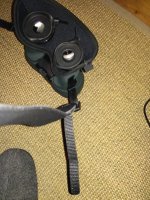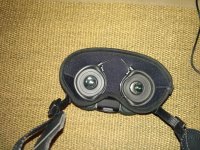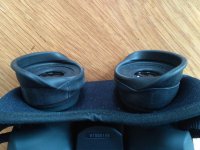I’ve been away from this forum for many years. Main reason was that I got the binoculars I wanted and had not much to desire. My main bins for the last 12 years were the canon 12x36 II (good advice Sancho). I’ve also got a pair of Hawke 8x43 frontier ED for rainy days. Also a Nikon 8x32 SE that will be up for sale soon because I have hardly used them despite their great optics. I don’t think I will use them much in the future. (no IS, not waterproof). Because this site is such a great resource for good advice I thought it would be good to return the favor. You never know who might find this usefull 
My Canon 12x36 have reached their end of life. The rubber coating has become so sticky that for the last 5 years or so I needed duct tape to cover this. On top of that they sometimes seem to jam inside when I use the focus wheel. Of coarse it is a shame that the bins are deteriorating so fast but I’ve not for a single moment regretted buying these. They have been a joy to use. The IS feature is really great. So I decided to buy a new pair of IS binoculars. I have been looking at the 10x32 but these were so incredibly expensive that I was thinking that maybe I should buy the 10x30. The problem with these is that they also seem to suffer from sticky rubber coatings. And close focus should be better. Last black friday offer on the 10x32 (euro 749) was good enough to go to the shop and try them. I knew the eyecups could be a big issue but it was not big enough not to buy them. (more on this later). One week later they were selling at euro 699. :C One phone call was enough to get the 50 euro back.
Build quality
The coating is different from the 12x36 and that hopefully means that these will not get sticky after some years. The material feels better. The overall quality feels good. A little heavier but better than the 12x36 II.
Optics
I’m far from an optics expert so I do not think I have much to add to Henry Links great review. To me the optics seem really great. Brighter then my 12 year old 12x36 and also better edge sharpness although to me that is not really that important. Overall images is just very good. I guess my Nikon 8x32 SE wins but not by that much.
Close focus
This feature is just great. It is something I missed with the 12x36. To my eyes it is less then the 2 meters that is advertised which is just great. Although the butterflies are gone now I am already looking forward to viewing these next spring/summer.
IS buttons
The great improvement over the 12x36 is that you can press once and then keep viewing for 5 minutes until it automatically stops the IS feature. I have not tried this out because 5 minutes is quite a period. If you forget to press again in order to stop the IS feature fthis is not a problem because the IS will stop after 10 seconds when the binoculars are held in a vertical position like hanging around your neck.The position of the buttons is not great. It is too far to the right for my right index finger to be comfortable. The button on the 12x36 was in a better position. Luckily you only have to press once. If I had to press continuously ( like on the 12x36) this would really be a problem.This bins have 2 IS buttons but I still have not figured out what the difference is in real life. They seem to do the same thing (engage IS/stop IS) and they do this very well. I guess I have to experiment a little more to see the difference.
Why 10x32 and not 12x32 or 14 x32
My birding is mainly in woodland, parks, gardens and every now and then the Dutch polders so there really is no need for higher magnifications. Over the years I also found out that a wider FOV and DOF was more important to me than more magnification. I understand that IS is appreciated more when magnification increases but that is no reason for me go give up on FOV and DOF requirements.Lucky for me, the Canon marketing department seems to think that lower magnification justifies a lower price . It is a shame they don’t sell 8x32.
. It is a shame they don’t sell 8x32.
Strap with ends on the outside instead of inside
The manual shows you how to apply the neck strap to the bins. The problem I am having is that I like my bins to hang rather high. This means that the ends of the strap (hanging on the inside) are blocking the eye piece every now and then. So I just reversed this so the end of the strap hangs on the outside. See picture. Alternatively you can just cut the ends off but I hate to cut things of because it is mostly irreversible.
Eyecups
Although the eyecups were not so bad not the buy these bins, I can understand all the criticism they’ve had. As others have stated it also puzzles me why a big company like Canon can not produce proper eyecups for these. The ones I had on my 12x36 were just fine for me so how can it be that they can not fit proper ones on more expensive bins. It is just a piece of rubber.
My problems (as a non eyeglass wearer) were this:
When unfolded the field of view does not seem to be as large as it should be. The edge of the eyecups rims just irritate on my nose. The eye cups are just way too wide and have a sharp rim.
When folded down I get some vignetting and find it hard to hold them exactly in a position to get a perfect view. So I I’ve searched this forum (and others) to see what solutions people have come up with. This is what I found (in order of reversibility/mutilation)
1.Nothing
Some people seem to be fine with the eye cups folded up (non glasses wearers) or folded down (with eye glasses)
2.Half way folded position
https://www.cloudynights.com/topic/586499-canon-launch-3-new-is-binos/page-4#entry8686172
I tried this and it sure is a great improvement. The only problem is that they seem to fold back quite often.
3.Add BinoBlocker
Henry Link wrote about these.
https://www.birdforum.net/showpost.php?p=3820499&postcount=42
I tried them. They do a great job but still I was not 100% satisfied. When the rubber is folded down the bino blocker really adds to the viewing experience but I’m still having difficulty placing and holding the bins in a proper position. I think that I will keep the bino blockers on any way because they keep stray light out.
4.Cut the rim off
This seems to be a relatively safe solution. If you do this precisely there is not much to lose I guess. Although this link is for the 15x50 this seams to be the same kind of eye cups. Doug wrote about this on birdforem and on cloudy nights.
https://www.cloudynights.com/topic/614469-canon-15x50-is-eyecups/#entry8518178
5.Cut them to your liking
Also this is for the 18x50 but the eye cups seem similar.
https://www.cloudynights.com/topic/534258-canon-18x50-is-eyecup-help/#entry7166938
My solution
So far I’ve come up with a variant on option 2. I’ve added 2 (reusable) tie wraps so that the half way folded eyecups do not fold back. I still have to see how this works in the long run. If I am not satisfied I might try option 4. If that result would be close to what I had on the 12x36 this would be just fine for me.
Cheers
Peter
My Canon 12x36 have reached their end of life. The rubber coating has become so sticky that for the last 5 years or so I needed duct tape to cover this. On top of that they sometimes seem to jam inside when I use the focus wheel. Of coarse it is a shame that the bins are deteriorating so fast but I’ve not for a single moment regretted buying these. They have been a joy to use. The IS feature is really great. So I decided to buy a new pair of IS binoculars. I have been looking at the 10x32 but these were so incredibly expensive that I was thinking that maybe I should buy the 10x30. The problem with these is that they also seem to suffer from sticky rubber coatings. And close focus should be better. Last black friday offer on the 10x32 (euro 749) was good enough to go to the shop and try them. I knew the eyecups could be a big issue but it was not big enough not to buy them. (more on this later). One week later they were selling at euro 699. :C One phone call was enough to get the 50 euro back.
Build quality
The coating is different from the 12x36 and that hopefully means that these will not get sticky after some years. The material feels better. The overall quality feels good. A little heavier but better than the 12x36 II.
Optics
I’m far from an optics expert so I do not think I have much to add to Henry Links great review. To me the optics seem really great. Brighter then my 12 year old 12x36 and also better edge sharpness although to me that is not really that important. Overall images is just very good. I guess my Nikon 8x32 SE wins but not by that much.
Close focus
This feature is just great. It is something I missed with the 12x36. To my eyes it is less then the 2 meters that is advertised which is just great. Although the butterflies are gone now I am already looking forward to viewing these next spring/summer.
IS buttons
The great improvement over the 12x36 is that you can press once and then keep viewing for 5 minutes until it automatically stops the IS feature. I have not tried this out because 5 minutes is quite a period. If you forget to press again in order to stop the IS feature fthis is not a problem because the IS will stop after 10 seconds when the binoculars are held in a vertical position like hanging around your neck.The position of the buttons is not great. It is too far to the right for my right index finger to be comfortable. The button on the 12x36 was in a better position. Luckily you only have to press once. If I had to press continuously ( like on the 12x36) this would really be a problem.This bins have 2 IS buttons but I still have not figured out what the difference is in real life. They seem to do the same thing (engage IS/stop IS) and they do this very well. I guess I have to experiment a little more to see the difference.
Why 10x32 and not 12x32 or 14 x32
My birding is mainly in woodland, parks, gardens and every now and then the Dutch polders so there really is no need for higher magnifications. Over the years I also found out that a wider FOV and DOF was more important to me than more magnification. I understand that IS is appreciated more when magnification increases but that is no reason for me go give up on FOV and DOF requirements.Lucky for me, the Canon marketing department seems to think that lower magnification justifies a lower price
Strap with ends on the outside instead of inside
The manual shows you how to apply the neck strap to the bins. The problem I am having is that I like my bins to hang rather high. This means that the ends of the strap (hanging on the inside) are blocking the eye piece every now and then. So I just reversed this so the end of the strap hangs on the outside. See picture. Alternatively you can just cut the ends off but I hate to cut things of because it is mostly irreversible.
Eyecups
Although the eyecups were not so bad not the buy these bins, I can understand all the criticism they’ve had. As others have stated it also puzzles me why a big company like Canon can not produce proper eyecups for these. The ones I had on my 12x36 were just fine for me so how can it be that they can not fit proper ones on more expensive bins. It is just a piece of rubber.
My problems (as a non eyeglass wearer) were this:
When unfolded the field of view does not seem to be as large as it should be. The edge of the eyecups rims just irritate on my nose. The eye cups are just way too wide and have a sharp rim.
When folded down I get some vignetting and find it hard to hold them exactly in a position to get a perfect view. So I I’ve searched this forum (and others) to see what solutions people have come up with. This is what I found (in order of reversibility/mutilation)
1.Nothing
Some people seem to be fine with the eye cups folded up (non glasses wearers) or folded down (with eye glasses)
2.Half way folded position
https://www.cloudynights.com/topic/586499-canon-launch-3-new-is-binos/page-4#entry8686172
I tried this and it sure is a great improvement. The only problem is that they seem to fold back quite often.
3.Add BinoBlocker
Henry Link wrote about these.
https://www.birdforum.net/showpost.php?p=3820499&postcount=42
I tried them. They do a great job but still I was not 100% satisfied. When the rubber is folded down the bino blocker really adds to the viewing experience but I’m still having difficulty placing and holding the bins in a proper position. I think that I will keep the bino blockers on any way because they keep stray light out.
4.Cut the rim off
This seems to be a relatively safe solution. If you do this precisely there is not much to lose I guess. Although this link is for the 15x50 this seams to be the same kind of eye cups. Doug wrote about this on birdforem and on cloudy nights.
https://www.cloudynights.com/topic/614469-canon-15x50-is-eyecups/#entry8518178
5.Cut them to your liking
Also this is for the 18x50 but the eye cups seem similar.
https://www.cloudynights.com/topic/534258-canon-18x50-is-eyecup-help/#entry7166938
My solution
So far I’ve come up with a variant on option 2. I’ve added 2 (reusable) tie wraps so that the half way folded eyecups do not fold back. I still have to see how this works in the long run. If I am not satisfied I might try option 4. If that result would be close to what I had on the 12x36 this would be just fine for me.
Cheers
Peter








